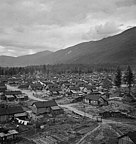Portal:Genocide/Selected article/10
From 1942 to 1949, Canada forcibly relocated and incarcerated over 22,000 Japanese Canadians—comprising over 90% of the total Japanese Canadian population—from British Columbia in the name of "national security". The majority were Canadian citizens by birth and were targeted based on their ancestry. This decision followed the events of the Japanese Empire's war in the Pacific against the Western Allies, such as the invasion of Hong Kong, the attack on Pearl Harbor in Hawaii, and the Fall of Singapore which led to the Canadian declaration of war on Japan during World War II. Similar to the actions taken against Japanese Americans in neighbouring United States, this forced relocation subjected many Japanese Canadians to government-enforced curfews and interrogations, job and property losses, and forced repatriation to Japan.
From shortly after the December 1941 attack on Pearl Harbor until 1949, Japanese Canadians were stripped of their homes and businesses, then sent to internment camps and farms in British Columbia as well as in some other parts of Canada, mostly towards the interior. The internment in Canada included the theft, seizure, and sale of property belonging to this forcefully displaced population, which included fishing boats, motor vehicles, houses, farms, businesses, and personal belongings. Japanese Canadians were forced to use the proceeds of forced sales to pay for their basic needs during the internment. (Full article...) (Full article...)

